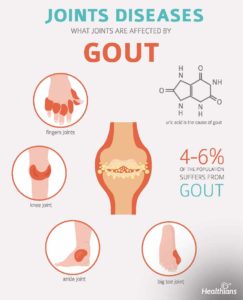Contributed by – Healthians Team
You wake up in the night, with excruciating pain in your feet, with a feeling as if your toe is on fire and yes, your toe is swollen and bright red … wondering what it is? It is not normal; you need to consult your doctor, as you are suffering from GOUT.
Gout is a term used for a variety of conditions that are mostly caused by increased levels or buildup of uric acid. It is a very common and mostly a complex form of arthritis, in which the big toe is the first place to get affected.

Signs
The big toe is the most common place of Gouts attack, and the flare-ups can last up to 10 days. The other commonly affected joint are ankles, elbow, wrists, and finger. Gout attacks reach their most painful stag within 12-24 hours and can last for a few days to even weeks.
The typical signs of a Gout attack are
- A sudden and severe pain that is mostly experienced in the middle of the night or early morning.
- Lingering discomfort is experienced even after severe pain has subsided. The distress caused can last for a few days.
- There will be tenderness in the joint, warm to touch and a red or purple look.
- Joint stiffness will be there that will cause limited movement.
Gout usually affects one joint at a time, but if left untreated, other joints can also be affected.
Symptoms
Gout symptoms usually occur in 4 phases, these include:
- Asymptomatic Hyperuricemia
- Acute Gout
- Interval Gout
- Chronic Gout
All these stages have different symptoms, and hence the treatment is planned according to the stage.
Asymptomatic Hyperuricemia
It is the initial and the asymptomatic stage, in which only the uric acid levels are elevated in the blood.
Acute Gout
In this stage, the elevated uric acid levels lead to the formation of uric crystals that can develop in any one of the joints. It leads to intense pain, swelling and a warm feel at the affected joint. The symptoms in the acute stage start suddenly and can last or 3 to 10 days. The patient may experience gout attacks throughout the month or years.
Interval Gout
This stage is also termed as Intercritical gout as it is the period between the acute gout attacks and it mostly shows no symptoms.
Chronic Gout
If gout is left untreated, then it can develop into chronic tophaceous gout. It takes almost ten years or more to reach this chronic stage. In this stage, there is the development of hard nodules or tophi on the joints, skin and the soft tissues surrounding them. These tophi can also develop in other parts of the body and can cause permanent damage. These crystals can further accumulate in the urinary tract leading to kidney stones.

Causes
Gout happens when there is the formation of urate crystals in the joints, that leads to inflammation and the intense pain or gout attack. These urate crystals are formed by increased levels of uric acid in the blood. The uric acid formation is a natural process, it gets dissolved in the blood and via the kidney passes into the urine. At times there is an overproduction of uric acid by our body, or our kidneys excrete very little of the uric acid, which ultimately leads to the formation of urate crystals.
The common risk factors that can lead to an increased level of uric acid are:
- A diet that is rich in meat, seafood, sweetened beverages
- Excessive alcohol consumption, especially beer
- Obesity or over-weight
- There are certain medical conditions like high blood pressure, diabetes, metabolic syndrome, heart and kidney diseases
- Certain medications like thiazide diuretics, low dose aspirin
- Genetic
- Age and sex, it is more common in men usually between the age of 30. In females, it is more common after menopause
- Recent surgery or trauma
- An injury or trauma to joint
- Dehydration
Time to visit the doctor
If you suddenly experience sudden and severe pain, it is always advised to consult a doctor because if left untreated, it can lead to more severe pain, even joint damage. If the pain is accompanied by fever and the joint looks warm and inflamed, it could be a sign of an infection; the best thing is to go for immediate medical attention.
Don’t ignore the initial signs, be mindful and stay healthy.




